Toad threat for Kimberley crocs

Cane toads and their inevitable march south have forced a second detailed survey of freshwater crocodiles at an iconic Kimberley tourist location as their arrival threatens local native species with extinction.
The reptiles were surveyed at the Windjana Gorge National Park, 355km east of Broome, last month by the Department of Parks and Wildlife and Bunuba Rangers, with support from volunteers and non-government organisation Rangelands NRM.
Sawfish and turtles captured in nets were also tagged and released.
Rangelands NRM program manager (Kimberley) Grey Mackay said collaboration was key to getting good outcomes on the ground and reducing impacts of cane toads on native species.
“Only through aligning Federal, State and community efforts can we make a difference,” he said.
Parks and Wildlife West Kimberley nature conservation coordinator Tracy Sonneman said cane toads could be fatal to native species, including freshwater crocodiles, if ingested.
“It is vital we gain baseline data about the population of freshwater crocodiles in Windjana Gorge and nearby pools in the Lennard River prior to the arrival of cane toads,” she said.
“This is the second year the survey has been carried out and it is providing us with good information about population structure and mobility, with 78 freshwater crocodiles collected, processed and released this year.”
She said the State Government cane toad strategy identified this project as a priority, to help maximise understanding of cane toad impacts on freshwater crocodiles at important Kimberley locations.
Twenty-three people participated in the survey including two Ngarla Rangers from Port Hedland as part of a volunteer exchange program with representatives from zoos around Australia.
After netting the pools, experts handled the trapped crocodiles while volunteers helped measure them, take samples for genetic testing and check that they were in good condition.
Mr Mackay said the sheer number of cane toads travelling across the Kimberley could result in localised extinctions of certain species.
“This project seeks to better understand where we can possibly reduce the impacts of cane toads,” he said.
“Through education, awareness and engagement, indigenous ranger groups are playing a key role in caring for their environment and working to reduce the impacts of cane toads on native species.”
Get the latest news from thewest.com.au in your inbox.
Sign up for our emails
